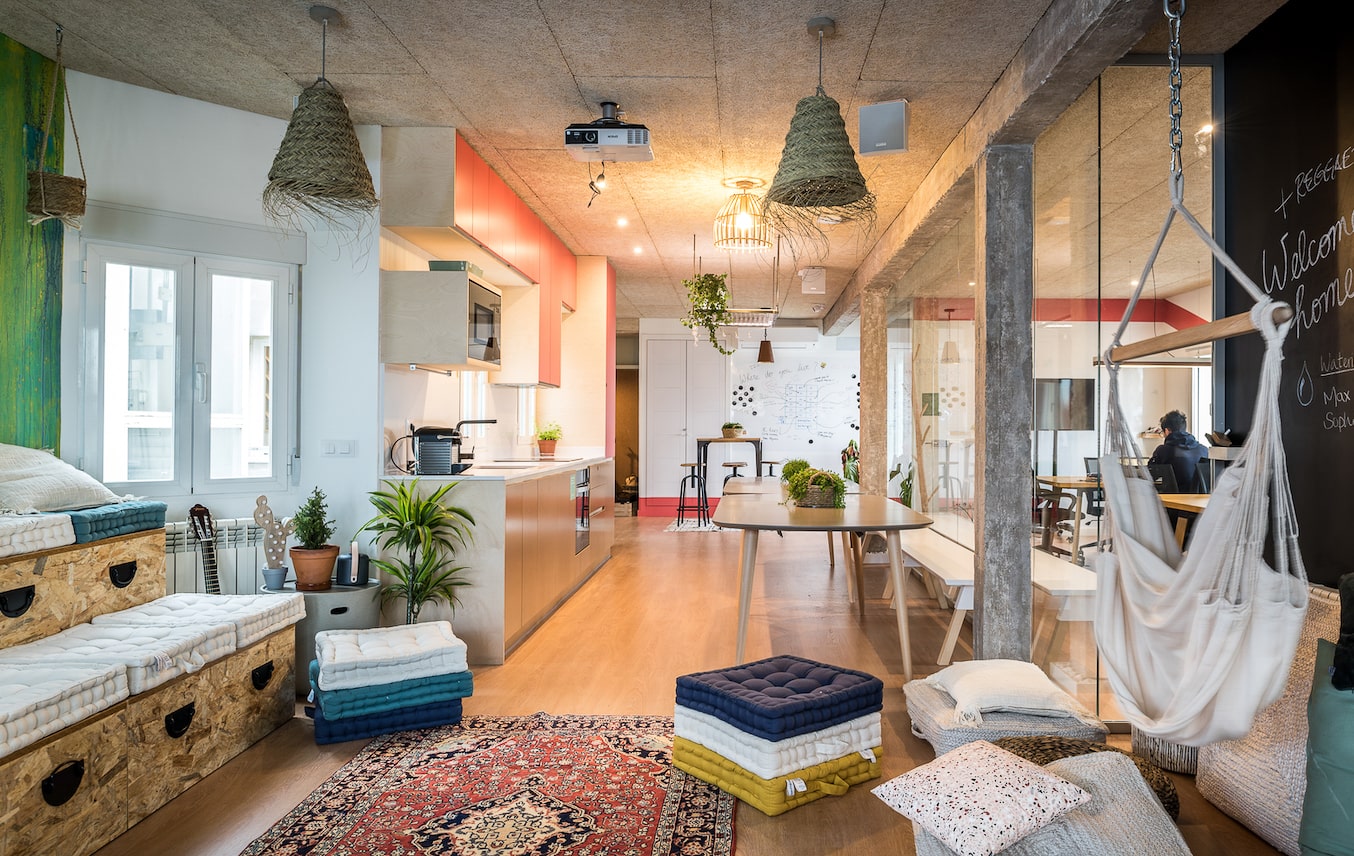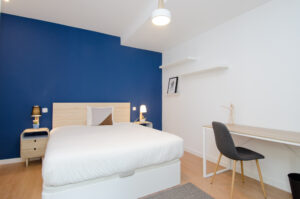Are you considering coworking or coliving, or are you just curious about the evolving landscape of shared spaces?
This article is your go-to guide!
Coworking and coliving are emerging as the next big thing in real estate trends, with the global coworking market anticipated to grow significantly from $9.2 billion registered in 2022 to $34.5 billion by 2032, expanding at an alarming compounded annual growth rate (CAGR) of 14.6%, as per Allied Market Research. Concurrently, other studies also project exponential growth for the coliving market.
In this coverage, we will unravel the dynamics of these transformative trends, providing insights, perspectives, and a glimpse into the exciting future of collaborative living and working.
Explore expert financial guidance with Stephen Blake as we delve into these transformative realms. Stephen’s expertise, showcased in this collaborative blog post, offers invaluable perspectives. Let’s dive right in!
The Rise of Coliving and Coworking

Coliving and coworking have experienced a remarkable surge in popularity as real estate trends, capturing the essence of the evolving global work and living dynamics. Today, there are over 5 million coworkers worldwide, and this number is expected to experience even more significant growth.
As already seen, the report by Allied Market Research projects a substantial annual growth rate of 14.6%, aligning closely with the 13% projection by Team Stage. Notably, the embrace of co-shared workspaces is evident among SMEs, with 37.93% utilizing these collaborative environments.
In this thriving ecosystem, the appeal of coworking extends beyond mere statistics. 84% of coworkers express heightened engagement and motivation when working alongside their peers. This statistic underscores the anticipation of further expansion in coworking, where collaborative environments foster creativity, productivity, and even better mental health.
Meanwhile, in the realm of coliving, the chronic housing shortage we’re currently facing is expected to intensify in the coming years. Projections indicate that 9% of the global population will reside in 42 mega cities by 2030, with two-thirds expected to inhabit metro areas by 2050.
Coliving consultant Leah Zilliac commented on these numbers, stating, “There simply isn’t enough housing to match these numbers. Coliving will (and must) play a role in helping to meet these demands in the future.”
In other words, as we explore the landscapes of coliving and coworking, it becomes evident that these innovative models are not merely trends but integral solutions shaping the future of work and living.
Importance of Adapting to Modern Work and Lifestyle Trends

A lot has changed over the years in how we approach work and lifestyle. Thanks to population growth, technology, increased knowledge, and other triggers of change, almost all spheres of life have been affected by the wave of transformation, and this includes the commercial real estate landscape.
For instance, gone are the days when a homebuyer had to attend countless in-person meetings to negotiate on a few elements when buying a house. Nowadays, remote buying of real estate has taken over, and that’s just one of the many palpable changes we’re witnessing in the housing market.
Coliving and coworking are other transformative trends, underscoring the inevitability of the changes happening in our current world.
But then, what is the importance of adapting to modern work and lifestyle practices, you may ask?
Well, here are some benefits:
- Flexibility and Autonomy: Modern trends in work and lifestyle offer unprecedented flexibility. The shift to remote work allows individuals to structure their workdays in a way that suits them best, fostering a sense of autonomy.
- Global Connectivity: The influence of technology has shattered geographical barriers. Coliving and coworking spaces provide a platform for global connectivity, enabling professionals to collaborate and connect across borders.
- Economic Considerations: Embracing modern work and lifestyle trends can be economically advantageous. Remote work reduces the need for extensive office space, leading to cost savings for businesses. Similarly, coliving arrangements often offer more affordable living options than traditional housing.
- Wellness and Community: There’s an increasing recognition of the importance of wellness in the workplace. Coliving spaces are designed with community and well-being in mind, providing shared amenities and communal areas that contribute to a holistic living experience.
- Work-Life Integration: Modern trends encourage a seamless integration of work and life. The distinction between professional and personal spheres is becoming less rigid, allowing for a more balanced and harmonious lifestyle.
In essence, the changing dynamics of work and lifestyle underscore the need to adapt to modern real estate trends. Remote work, remote real estate transactions, coliving, and coworking are not just trends; they represent a paradigm shift that emphasizes flexibility, connectivity, and a holistic approach to life and work. As we navigate this transformative era, embracing these trends becomes not only beneficial but essential for thriving in the evolving landscape.
Coliving Trends

In recent years, coliving has witnessed a remarkable surge in popularity as societal and work dynamics undergo a transformative shift. Individuals are increasingly drawn to the concept of shared living that extends beyond traditional accommodation models. This trend is driven by a desire for community, flexibility, and enhanced social interaction.
The Concept of Coliving
Coliving represents a departure from conventional housing arrangements, emphasizing not just shared physical spaces but the cultivation of a vibrant and supportive community.
It is a holistic approach to living that caters to a diverse demographic, offering an experiential lifestyle beyond mere cohabitation. Residents actively engage in communal activities, fostering a sense of belonging and shared purpose and finding a way to work around the escalating home prices.
The concept aligns with the evolving preferences of a generation seeking meaningful connections and collaborative living experiences.
Demand for Coliving Spaces
The escalating demand for coliving spaces reflects a cultural shift in housing preferences. The mobile workforce, in particular, finds appeal in the flexibility and convenience offered by coliving arrangements.
Millennials, as per LinkedIn, were initially the main driving force behind these real estate trends, owing to the social dynamics and cost-effectiveness inherent in shared living. However, demographics have shifted with time, with 2023 stats now showing older adults, including baby boomers and retirees, embracing the coliving arrangement.
The integration of workspaces within coliving environments adds an extra layer of attractiveness, aligning with contemporary expectations of seamless work-life integration.
Key Features of Successful Coliving Spaces
Successful coliving spaces exhibit distinct features that contribute to their popularity and functionality:
- Community-Centric Design: Thoughtfully crafted spaces that encourage social interaction through shared kitchens, lounges, and recreational areas. Design elements promote spontaneous connections among residents, fostering a sense of belonging.
- Flexibility in Leasing: Offering short-term leases provides residents the freedom to adapt to changing circumstances. This flexibility aligns with the dynamic nature of modern lifestyles, catering to a diverse demographic, including digital nomads and short-term project-based workers.
- Integrated Workspaces: Recognizing the importance of work-life balance, successful coliving spaces incorporate dedicated workspaces. These areas are equipped with amenities like high-speed internet and comfortable seating, creating a conducive environment for remote work.
- Amenities and Shared Resources: Beyond individual living units, coliving spaces provide communal amenities such as fitness centers, coworking spaces, and laundry facilities. Shared resources, including utilities and internet, contribute to cost-effectiveness for residents.
- Conflict Resolution Protocols: Conflicts are inevitable no matter who’s around us, so clear guidelines and mechanisms for conflict resolution are crucial for maintaining a harmonious living environment. Establishing transparent communication channels and addressing issues promptly contribute to the overall well-being of the community.
- Cultural and Lifestyle Programming: Successful coliving spaces often curate cultural and lifestyle events. These can include workshops, social gatherings, and skill-sharing sessions, enhancing the overall experience and fostering a sense of community engagement.
- Environmental Sustainability: A growing focus on sustainability is observed in successful coliving spaces. Incorporating eco-friendly practices, such as solar power, energy-efficient appliances, and waste reduction initiatives, resonates with environmentally conscious residents.
These features collectively define the success of coliving spaces, creating environments that not only meet the functional needs of residents but also contribute to a thriving and interconnected community.
Coworking Trends

The evolution of workspace dynamics has brought forth significant real estate trends in the coworking landscape. As professionals seek flexible and collaborative environments, coworking spaces have adapted to meet these changing needs.
The Concept of Coworking
Coworking revolutionizes traditional office setups by providing shared workspaces that foster collaboration and flexibility. It goes beyond mere physical spaces, emphasizing a community-driven approach where diverse professionals coexist, share ideas, and collaborate.
The benefits of coworking extend beyond a desk; it’s a dynamic environment that caters to freelancers, entrepreneurs, and remote workers, offering an alternative to traditional office settings.
This shared space not only provides a cost-effective and adaptable work environment but also creates a vibrant community where the benefits of coworking, such as networking opportunities and shared resources, become integral to professional growth and a fulfilling work experience.
Growth of the Coworking Industry
The coworking industry has experienced exponential growth since 2010, impacting property management, driven by the rise of the gig economy, remote work trends, and a shift in professional preferences.
This flexible workspace solution has become a mainstream choice for individuals and businesses seeking cost-effective, adaptable, and community-oriented work environments. The industry’s trajectory signals a fundamental change in how people approach workspaces.
Essential Elements of Coworking Spaces
Successful coworking spaces exhibit key elements that contribute to their popularity and functionality. Some of these common trends include:
- Flexible Workspaces: Coworking spaces include adaptable layouts that cater to diverse work styles, providing open areas for collaboration, private offices for focused work, and communal zones for informal discussions.
- Community Atmosphere: Fostering a sense of community through networking events, skill-sharing workshops, and shared spaces that encourage spontaneous interaction. Coworking spaces often have community managers to facilitate connections among members.
- Technology Integration: Equipping spaces with cutting-edge technology, including high-speed internet, video conferencing facilities, and smart office solutions. This enables seamless collaboration and connectivity for remote workers.
- Amenities and Services: Offering amenities such as well-equipped coffee bars, comfortable lounges, and concierge services. Some coworking spaces even provide fitness facilities and wellness programs to enhance the overall work experience.
- Accessibility: Convenient locations with easy access to public transportation, parking, and essential services. Proximity to restaurants, cafes, and other amenities contributes to the convenience of coworking spaces.
- Customization Options: Allowing members to personalize their workspaces with adjustable desks, ergonomic furniture, and even branding opportunities. This creates a sense of ownership and comfort, enhancing the overall work environment.
- Networking Opportunities: Facilitating networking through organized events, industry-specific meetups, and online platforms. Coworking spaces often have dedicated spaces for networking, encouraging collaboration and professional growth.
- Sustainability Practices: Incorporating eco-friendly initiatives, such as energy-efficient lighting, recycling programs, and sustainable materials in construction. This commitment to sustainability aligns with the environmental consciousness of many professionals.
These essential elements collectively contribute to the success of coworking spaces, creating environments that not only meet the practical needs of professionals but also nurture a collaborative and vibrant community.
Conclusion
In our evolving world, coliving and coworking are the surging real estate trends in the market. Over 5 million people globally are coworking, with a projected 14.6% annual growth. Coliving addresses an impending housing shortage by 2030. Adapting to modern work trends is crucial, offering flexibility, global connections, and greater affordability. Remote work and shared spaces redefine our work-life approach. Coliving fosters wellness, while coworking emphasizes community and collaboration, benefitting freelancers, entrepreneurs, and remote workers. Embracing these trends is essential for a more dynamic and interconnected future.


























